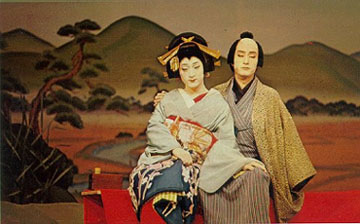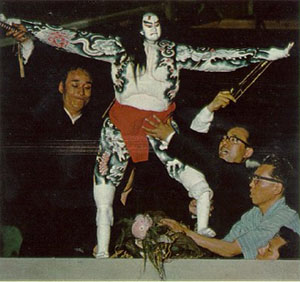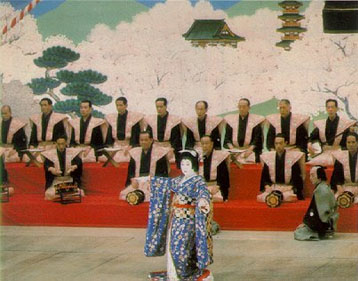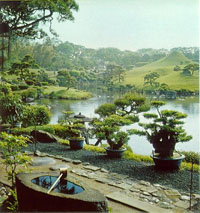Japan today

III.2 Japanese arts
There are a lot of different Japanese arts: pottery, calligraphy (with their incomprehensible letters), traditional prints, martial... But one of the most important is probably the theatre, due to its popularity and its three typical styles : No, Kabuki, and a very different one, Bunraku;No is the result of a long creation: Farmers, in ancient times had the Dengaku Festival dedicated to the God of the rice paddies. In addition, there was Sangaku music introduced from the Asian mainland, by way of Korea, some 1,000 years ago.
 This later became Sarugaku, which gave birth to No. Practically, No is a very poetic and aristocratic theatre with very slow body language. Kabuki was born in the XVIIth century when an actress named Okuni performed in Kyoto. Kabuki theatre is a kind of entertainment, played by itinerant bands, with dance and music which lasts five hours (!). Still, No was theatre for the Samurais and Kabuki was for the common man... The last one is very different. Bunraku is a theatre form within Sangaku tradition where the manipulators are present on the scene. After shamisen (3-cords guitar) replaced biwa (4-cords lute) accompaniment in the mid-XVIth century, Bunraku became popular with the masses in the XVIIIth century with the emergence of the famous playwright Chikamatsu.
This later became Sarugaku, which gave birth to No. Practically, No is a very poetic and aristocratic theatre with very slow body language. Kabuki was born in the XVIIth century when an actress named Okuni performed in Kyoto. Kabuki theatre is a kind of entertainment, played by itinerant bands, with dance and music which lasts five hours (!). Still, No was theatre for the Samurais and Kabuki was for the common man... The last one is very different. Bunraku is a theatre form within Sangaku tradition where the manipulators are present on the scene. After shamisen (3-cords guitar) replaced biwa (4-cords lute) accompaniment in the mid-XVIth century, Bunraku became popular with the masses in the XVIIIth century with the emergence of the famous playwright Chikamatsu.
 Nowadays it's a speciality of the city of Osaka.
Nowadays it's a speciality of the city of Osaka.However, one of the main characteristics of Japanese art is a constant search for eternal oneness with nature. For example, in the tea ceremony or flower arrangement (that every good housewife has to master) with their seasonal accessories. Haiku, the Japanese poetry, has a traditional commitment to seasonal terms, too, and these are explained in Saijiki:
| Kiku no ka ya | (The scent of chrysanthemums) |
| Nara ni wa furuki | (Long resident in Nara) |
| Hotoketachi | (Buddhist spirits) |
 And this is the same for each other seasons, spring chrysanthemums would have to be indicated by "kikunae" (nae: young) or "kikuwakaba" (wakaba: young leaves), summer ones by "natsugiku" (natsu: summer), and winter ones by "kangiku" (kan: coldness, winter). It is characteristic of Japanese art to present nature as it truly is (The Japanese use the term : shakkei, which literally means borrowing scenery). For example, whereas the typical Western garden would have a geometrically-designed flower bed and a fountain, the Japanese strive to retain the beauty of nature by planting trees, placing rocks, and ones) providing a flow for water in the pond. In this way, they create the famous Zen gardens.
And this is the same for each other seasons, spring chrysanthemums would have to be indicated by "kikunae" (nae: young) or "kikuwakaba" (wakaba: young leaves), summer ones by "natsugiku" (natsu: summer), and winter ones by "kangiku" (kan: coldness, winter). It is characteristic of Japanese art to present nature as it truly is (The Japanese use the term : shakkei, which literally means borrowing scenery). For example, whereas the typical Western garden would have a geometrically-designed flower bed and a fountain, the Japanese strive to retain the beauty of nature by planting trees, placing rocks, and ones) providing a flow for water in the pond. In this way, they create the famous Zen gardens.